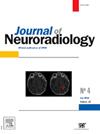Neuroanatomical features of NAA10 and NAA15-related neurodevelopmental syndromes
IF 3
3区 医学
Q2 CLINICAL NEUROLOGY
引用次数: 0
Abstract
Background
NAA10-related and NAA15-related neurodevelopmental (ND) syndromes present with intellectual disability, hypotonia, cardiac abnormalities, and delayed development. While data exists on the clinical manifestations of these conditions, there are few reports describing the neuroanatomical abnormalities present on imaging.
Objective
We aim to provide neuroimaging analyses for a subset of probands with NAA10- and NAA15-related neurodevelopmental symptoms and assess the severity and number of neuroanatomical anomalies and their associated functional impairments to better understand the pathophysiology of these disease processes.
Materials and methods
Neuroimaging studies were obtained from 26 probands (18 with pathogenic variants in NAA10, 8 with pathogenic variants in NAA15) and evaluated. In depth medical histories were also collected on probands, including genetic testing results and developmental history. The Vineland 3 Adaptive Behavior Scale was also administered to assess functional status of the probands.
Results
On average, individuals with NAA10-related ND syndrome had 5.7 anatomical abnormalities (standard deviation (SD) = 3.0), whereas those with NAA15-related ND syndrome had 2.8 (SD = 2.3, p = 0.02). Probands with a greater number of anatomical abnormalities tended to score worse on Vineland assessments. Structure and function were correlated such that individuals with greater defects on, for example, motor regions of their scans, tested worse on motor portions of the Vineland. Probands followed longitudinally demonstrated several changes between scans, most commonly in the cerebellum, brainstem, and degree of myelination. Such changes were only observed for probands with NAA10-related ND syndrome.
Conclusion
This analysis of a cohort of probands with NAA10-related ND syndrome and NAA15-related ND syndrome by two neuroradiologists has established a range of subtle abnormalities. We hope these findings guide future research and diagnostic studies for this population.

NAA10和naa15相关神经发育综合征的神经解剖学特征
naa10相关和naa15相关的神经发育(ND)综合征表现为智力障碍、张力低下、心脏异常和发育迟缓。虽然有关于这些疾病的临床表现的数据,但很少有报道描述影像学上出现的神经解剖异常。目的:为NAA10-和naa15相关神经发育症状的先显子提供神经影像学分析,评估神经解剖异常及其相关功能损伤的严重程度和数量,以更好地了解这些疾病过程的病理生理学。材料和方法对26个先证者(18个NAA10致病变异,8个NAA15致病变异)进行神经影像学研究并进行评估。深入收集先证者的病史,包括基因检测结果和发育历史。采用Vineland 3适应行为量表评估先证者的功能状态。结果naa10相关ND综合征患者平均解剖异常5.7例(标准差(SD) = 3.0), naa15相关ND综合征患者平均解剖异常2.8例(SD = 2.3, p = 0.02)。解剖异常较多的先证者往往在Vineland评估中得分较低。结构和功能是相关的,例如,在扫描的运动区域有较大缺陷的人,在Vineland的运动部分测试中表现较差。纵向先证者在扫描之间显示出一些变化,最常见的是在小脑、脑干和髓鞘形成程度。这种变化仅在naa10相关ND综合征的先证者中观察到。结论:两位神经放射学家对naa10相关ND综合征和naa15相关ND综合征的先证者队列进行了分析,确定了一系列微妙的异常。我们希望这些发现能够指导未来对这一人群的研究和诊断研究。
本文章由计算机程序翻译,如有差异,请以英文原文为准。
求助全文
约1分钟内获得全文
求助全文
来源期刊

Journal of Neuroradiology
医学-核医学
CiteScore
6.10
自引率
5.70%
发文量
142
审稿时长
6-12 weeks
期刊介绍:
The Journal of Neuroradiology is a peer-reviewed journal, publishing worldwide clinical and basic research in the field of diagnostic and Interventional neuroradiology, translational and molecular neuroimaging, and artificial intelligence in neuroradiology.
The Journal of Neuroradiology considers for publication articles, reviews, technical notes and letters to the editors (correspondence section), provided that the methodology and scientific content are of high quality, and that the results will have substantial clinical impact and/or physiological importance.
 求助内容:
求助内容: 应助结果提醒方式:
应助结果提醒方式:


